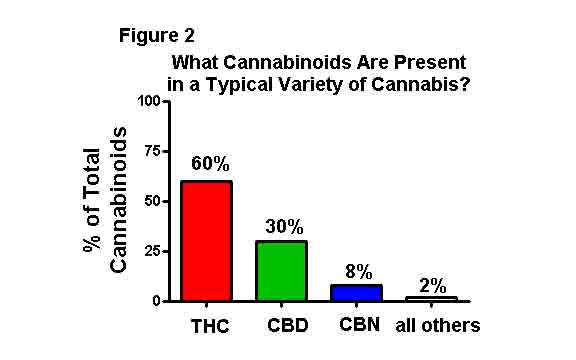
This is a short article composed mainly of a set
of graphs which represent some of my original research
on the subject and a specific case as to
why we need more study on this valuable plant.

Figure 1 shows the approximate composition of
a cannabis flower, better known as a “bud” which is mostly
what people think of when they think of smoking
pot. Most of the bud that a person ingests is fibrous material
and water, and cannabinoids make up only a small
fraction of the total.

Figure 2 shows a graph of the percentages of various
cannabinoids in a typical strain. THC (delta 9-tetrahydrocannabinol)
is the predominant cannabinoid present in marijuana,
and often is considered “the” active ingredient in pot. Marijuana
contains
many different chemicals similar to THC, including
CBD and CBN, among others. CBD is a non-psychoactive chemical
precursor to THC and is present in very high
amounts in so-called “hemp” or “ditchweed.” As the marijuana plant
matures,
some of the THC is converted to CBN, which may
have even higher activity than THC, as shown in Figure 3.

Figure 3 is a possible explanation of why sometimes
smoking pot gets you high and sometimes it makes you feel stoned.
THC is thought to induce euphoria and creativity,
otherwise known as a “head buzz.” CBN gives you a “body buzz”
or feeling of calmness and pain relief.
CBN can be a powerful component of the beneficial effect of marijuana,
even
though it is often present at much lower concentrations
compared to THC. CBD has very little psychoactive effect,
although it might help with some diseases.

Figure 4 shows why coffee shops in Amsterdam have
so many varieties available. Most cannabis strains
are blends between Cannabis sativa and Cannabis
indica, and so the cannabinoid content would be somewhat
intermediate between the two. In general,
sativa strains are more purely THC in composition, while indica
strains include a much larger component of CBN.
Ruderalis or hemp, has a very little THC or CBN because
of a genetic mutation that prevents the conversion
of CBD to those other cannabinoids. Smoking too much
hemp will give you nothing but a headache, but
you might be able to make a nice shirt out of it.

Figure 5 represents a real experiment that I performed
on a marijuana smoker who suspected that he
had type two diabetes. After large meals,
he would tend to feel lethargic and sleepy, and he thought
that marijuana might help him, so we tried it
out. I tested his blood sugar many times before and after
he ate a large meal that contained a lot of carbohydrates
and after he smoked a marijuana cigarette.
As you see, his blood sugar levels increased more
than eighty points after the meal and stayed high for 45-50 minutes,
but then rapidly dropped after he smoked a marijuana
cigarette. There were some problems with this experiment,
namely that I didn’t know the exact cannabinoid
composition of the marijuana we were using and that I only got to do
the experiment one time on this individual.
In other experiments, I showed that marijuana reduces the blood sugar in
healthy subjects both after meals and during
fasting conditions.
In another experiment, I traveled to Amsterdam
with a patient who had problems with nausea, and determined that
very strong sativa strains were the most helpful
for him, as opposed to the indica strains which I as a healthy person
preferred. Smoking too much of the sativa
gave me a head rush, and I felt like I had to lie down, yet smoking the
indica strains didn’t soothe his stomach as well
as the sativa.
One time I drizzled some liquid THC from a Marinol
capsule onto a marijuana cigarette, thereby “spiking” the joint
with extra THC, and gave it to someone suffering
from severe nausea and saw him stop vomiting and start eating.
So with various bits and pieces of research that
I’ve been able to accomplish in the last few years, I have been able
to come up with some tentative conclusions.
One of my conclusions is that it would be nice
to be able to do more of this research. Nothing that I’ve presented
in this article cuts the mustard scientifically,
I freely admit, but it has been my very best effort to understand the medical
usefulness of this plant under an irrational
system of marijuana prohibition. If voters across the country keep
asking for
legal weed, things might change sometime very
soon and scientists can begin to study ganja in a more professional setting.
Tracy Blevins, better known as “Medical Marijuana
Barbie,” has a doctorate in pharmacology from the
University of Texas Houston Medical School and
currently works in the Department of Bioengineering at Rice University.
Tracy Blevins, Ph.D.
Medical Marijuana Barbie
http://houston.indymedia.org/uploads/3cdp.avi
Me giving the Beeyotch Treatment to Swift Boat
Liar For Bush John O'Neill
READ http://www.bartcop.com EVERY DAY